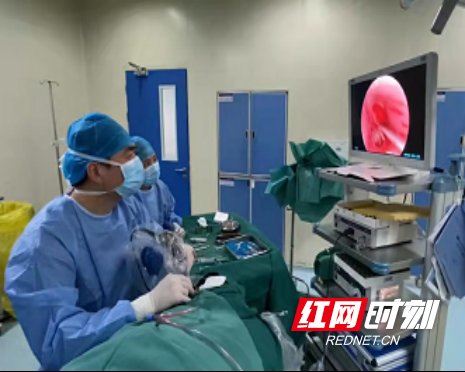
The doctor is operating on the patient.
Red Net Moment, February 25th (correspondent Wang Manjing and Qin Lu) Recently, 31-year-old Ms. Peng was on her way to work because the cold wind blew into her ear and felt tingling in her right ear. Changsha Central Hospital (Changsha Central Hospital Affiliated to South China University) went to the outpatient department of otolaryngology and head and neck surgery. Otoscopy showed a large perforation of the right ear tympanic membrane and hearing loss in the right ear. He was diagnosed with chronic otitis media, and the perforation needed to be repaired by surgery. Improve hearing.
“Doctor, my ears are usually fine, how could the eardrum be perforated?” Ms. Peng asked. Jing Qiancheng, chief physician and deputy chief physician of the Department of Otolaryngology and Head and Neck Surgery at Changsha Central Hospital (Changsha Central Hospital affiliated to South China University), inquired about her medical history in detail. Ms. Peng recalled that when she was about 8 years old, she had earache and was diagnosed as acute otitis media. Later, the doctor prescribed medicine and took it back to take the pain in her ear, and there was no reexamination. The previous analysis, the patient’s otoscope examination showed that the patient’s right ear tympanic membrane perforation and residual tympanic membrane calcification; audiology examination showed that the low-frequency hearing loss of the right ear. In general, calcification of the tympanic membrane is caused by chronic inflammatory stimulation. Combined with the patient’s medical history, it is considered that the patient’s tympanic membrane perforation has occurred during childhood acute otitis media, but it has not healed, and then insidiously develops chronic otitis media, resulting in hearing loss.
Jing Qiancheng said that acute otitis media can lead to perforation of the tympanic membrane, most of which are small needle-like perforations in the initial stage, which can be repaired by themselves after the inflammation is controlled, but we must pay attention to re-examination to confirm the recovery. If there is no healing, the disease is likely to develop silently, further aggravate hearing loss, or even develop other complications, with serious consequences.
On the morning of February 23, Jing Qiancheng successfully performed the right ear tympanoplasty for the patient. Preoperative high-resolution CT scan of the temporal bone showed that the patient’s middle ear structure was good and the ossicular bone was intact. Therefore, the perforation of the tympanic membrane was repaired by taking the patient’s tragus cartilage and periosteum. Jing Qiancheng said that the surgery is less traumatic, the incision is hidden, and the repair success rate is high.
My sincere introduction, tympanic membrane perforation is a common disease in the outpatient department of otolaryngology and head and neck surgery, which can lead to hearing loss and repeated infection of the middle ear. There are many causes of tympanic membrane perforation. Common causes are otitis media, including acute otitis media and chronic otitis media. The symptoms of acute otitis media are earache, ear fullness, hearing loss, and sometimes fever; the symptoms of chronic otitis media are pus from the ear canal, hearing loss, and in severe cases, headache, dizziness and other brain symptoms. Jing Qiancheng reminds the public that when they find ear discomfort, they must go to the hospital for medical diagnosis in time. If diagnosed with otitis media, seek professional treatment as soon as possible.